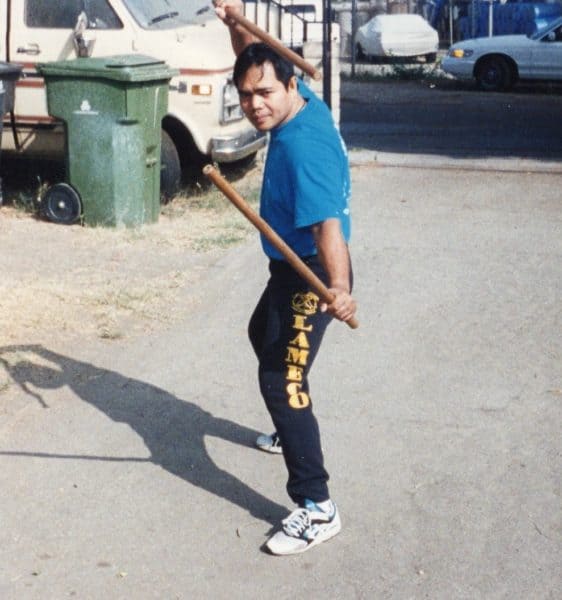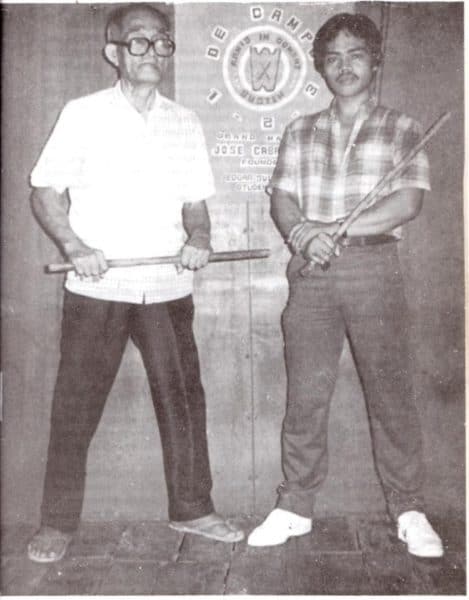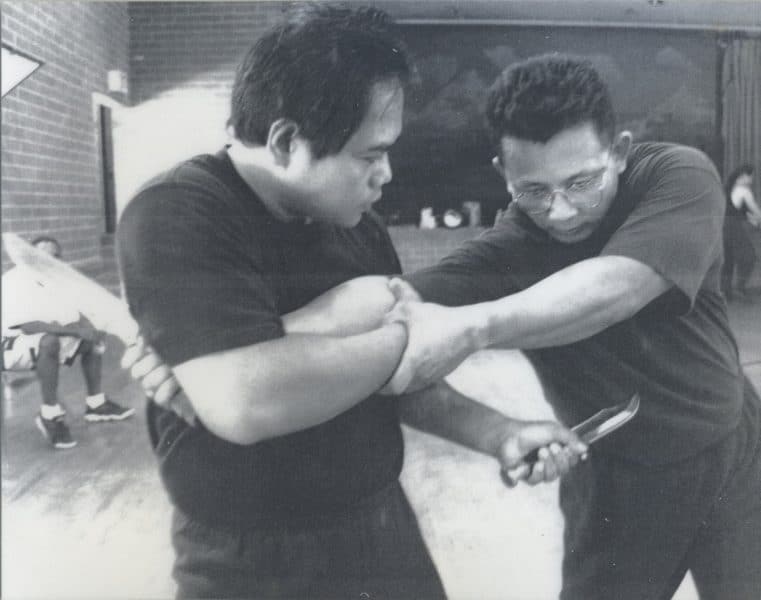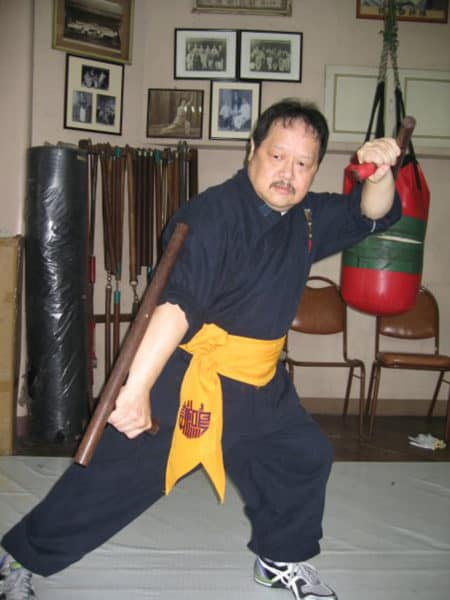Courtesy of: https://tambulimedia.com/alex-co-remembers-edgar-sulite/
*The following is an essay by Sifu Alexander Lim Co, excerpted from the book, Lameco Eskrima: The Legacy of Edgar Sulite.
I first met Edgar Sulite in the early 1980s under very unique circumstances. I was invited by Yuli Romo, an Arnis grandmaster, to attend a tournament sponsored by Master Picate. Yuli told me that the grandmaster considered the “King of Kings” in the field of Arnis, named Antonio “Tatang” Ilustrisimo, shall be present in the tournament. Usually, I don’t attend tournaments because I find them boring, as I am already used to their routines. But this time, curiosity got the better of me; I desired to meet the grand master touted to be the king of Arnis. Ironically, as even in kung-fu events, which is my field, I am hardly present; but in this event, with its system then alien to me, I was very visible.
 I asked my best buddy, Topher Ricketts, to come along with me. It was when we reached the tournament site that we found out that Yuli will challenge and fight a young master from Cagayan de Oro, one of the provinces of the Mindanao region. Their fight will be the main highlight of the event, using live sticks and without the use of body armor. Unfortunately, their anticipated fight did not push through, as Master Picate failed to come up with the prize money. Considering that the renowned masters were already in the venue, it was decided that there would be a demonstration where each master would be presented. In the event, I was introduced by Yuli to the great “Tatang” Ilustrisimo. I cannot remember the other demonstrators, but what I vividly remembered were the ones presented by Grandmaster “Tatang” Ilustrisimo and Ka Piryong Lanada of the Lanada Style. “Tatang” did the single baston, and Ka Piryong did the double baston. The reason why I singled out these two was simply because they were the ones I knew; “Tatang” having been introduced to me there by Yuli, and Lanada, who had been featured in Inside Kung-Fu magazine through the workings of his students in the U.S. So basically, knowledge wise at that time, I could not distinguish the versatility and salient points of their different styles.
I asked my best buddy, Topher Ricketts, to come along with me. It was when we reached the tournament site that we found out that Yuli will challenge and fight a young master from Cagayan de Oro, one of the provinces of the Mindanao region. Their fight will be the main highlight of the event, using live sticks and without the use of body armor. Unfortunately, their anticipated fight did not push through, as Master Picate failed to come up with the prize money. Considering that the renowned masters were already in the venue, it was decided that there would be a demonstration where each master would be presented. In the event, I was introduced by Yuli to the great “Tatang” Ilustrisimo. I cannot remember the other demonstrators, but what I vividly remembered were the ones presented by Grandmaster “Tatang” Ilustrisimo and Ka Piryong Lanada of the Lanada Style. “Tatang” did the single baston, and Ka Piryong did the double baston. The reason why I singled out these two was simply because they were the ones I knew; “Tatang” having been introduced to me there by Yuli, and Lanada, who had been featured in Inside Kung-Fu magazine through the workings of his students in the U.S. So basically, knowledge wise at that time, I could not distinguish the versatility and salient points of their different styles.
After the tournament, Yuli introduced me to Edgar Sulite, whom I noticed to be very well mannered, respectful and who projected an aura of self-confidence, though still younger than most masters. I had just finished publication of my first book on Ngo Cho Kun, and I was aware that there as a demand for reference materials for the ever-growing market of Arnis practitioners. During those times, the only available book on Arnis was the one published by Remy Presas.
 In the course of our conversation, publishing a book on Arnis came up. I thought a book on the art would be a great idea as the art of Arnis, though well-known in the Visayas and Mindanao regions, was then not so well-known in the metropolis of Manila and its neighboring cities. In fact, it was widely believed that Arnis was personified and represented only by the style of Remy Presas, who had established quite a name in this field, by virtue of his book. I found the young Edgar Sulite very skilled, educated and very passionate about Arnis. I gave my business card to him to pay me a visit, and sure enough, the following week, he appeared at my doorstep, presented me with a manuscript of his work, and was indeed looking for a publisher.
In the course of our conversation, publishing a book on Arnis came up. I thought a book on the art would be a great idea as the art of Arnis, though well-known in the Visayas and Mindanao regions, was then not so well-known in the metropolis of Manila and its neighboring cities. In fact, it was widely believed that Arnis was personified and represented only by the style of Remy Presas, who had established quite a name in this field, by virtue of his book. I found the young Edgar Sulite very skilled, educated and very passionate about Arnis. I gave my business card to him to pay me a visit, and sure enough, the following week, he appeared at my doorstep, presented me with a manuscript of his work, and was indeed looking for a publisher.
This started our business and personal relationship, and together with Topher Ricketts, we three established a lifelong friendship. Edgar would come to my office almost every day to discuss his book and demonstrate his Arnis knowledge to us. I would in turn expose him to the field of kung-fu, sharing my knowledge of Ngo Cho, Hung-gar, Praying Mantis, internal strength training, while Topher would delve into full-contact, pugilistic fighting with boxing basics and scientific training methods. So, in essence, we three became brothers in the martial arts, and at nighttime, would regularly practice at the penthouse of my residence in Makati.
Since the three of us were in constant company, I got to introduce Edgar and Topher to the different kung-fu masters, and Edgar also utilized some internal kung-fu techniques in his Lameco Eskrima, which explains his seemingly internal strength. I also learned Edgar’s Arnis style: Lameco. So the three of us each had knowledge in Arnis, Kung-fu, pugilistic fighting with specific strength on our own individual systems.
The publication of Edgar Sulite’s book was a great challenge to me. First, we had to change his original manuscript to be able to appeal to the readers. As I was more experienced in the field of book publishing I suggested we incorporate many items to make the book attractive enough to the readers, like putting its history, calisthenics, basics and fundamentals, strides, attack and defense techniques, closed inter-relations between a stick and dagger, plus introduction to some well-known masters. The latter was to expose these masters so their students would like to have their own copies, like a sort of marketing strategy. I published his first book with the title Secrets of Arnis.
 During those times, I normally traveled back and forth to Hong Kong, to buy stuff for my store, a hobby shop which specialized in model kits and radio control items from Japan and the U.S. Hong Kong, being an Asian free port, was much cheaper to buy goods than to import from their sources. I tried to find a distributor for Edgar Sulite’s Arnis book, but unfortunately I was told the market was not yet ripe for that kind of book, and instead was advised to come up with a book on knife techniques, which can be more profitable. I was able to find a worldwide distributor for a book on knife techniques, so after Edgar’s first book, we immediately came up with his second book, a book on knife techniques titled Advanced Balisong. Both books were distributed and well-received locally, and got positive reviews from practitioners. Unfortunately, the Hong Kong distributor I got for the knife book encountered domestic problems, and was forced to close his business, so the worldwide distribution of the book was thwarted, and instead we relied on National Bookstore, the Philippine’s primary book seller and distributor.
During those times, I normally traveled back and forth to Hong Kong, to buy stuff for my store, a hobby shop which specialized in model kits and radio control items from Japan and the U.S. Hong Kong, being an Asian free port, was much cheaper to buy goods than to import from their sources. I tried to find a distributor for Edgar Sulite’s Arnis book, but unfortunately I was told the market was not yet ripe for that kind of book, and instead was advised to come up with a book on knife techniques, which can be more profitable. I was able to find a worldwide distributor for a book on knife techniques, so after Edgar’s first book, we immediately came up with his second book, a book on knife techniques titled Advanced Balisong. Both books were distributed and well-received locally, and got positive reviews from practitioners. Unfortunately, the Hong Kong distributor I got for the knife book encountered domestic problems, and was forced to close his business, so the worldwide distribution of the book was thwarted, and instead we relied on National Bookstore, the Philippine’s primary book seller and distributor.
As a martial arts practitioner and publisher, I was greatly intrigued and mystified by the art of Arnis, with this style having no definitive roots. Where did this style originate? From what particular place? Although nobody can specifically say something very definite, I noticed that all styles have three similar movement concepts, although there are certain variations. These three are always present in any Arnis system, so there might be only one origin. These three are the concepts of doce pares, singko teros and siete pares. All Arnis styles rotate on these three concepts, although by now, there might already be numerous deductions and additions, as normally any martial arts system is accorded different adaptations by the master to make it particularly unique and his very own. Arnis styles are commonly defined and named after its master, so we have the Ilustrisimo style, the Lanada style, the Presas style, etc. while some still retain their ‘generic’ names like Lameco style, Balintawak style, Modern Arnis, etc. Because of the many questions in my mind regarding Arnis, I told Edgar to go to the different provinces and meet the prominent masters, interview them, get whatever knowledge is available, and delve deeper. With all provinces scattered around, I financed Edgar’s odyssey to these local destinations. He compiled all the data, which became the contents for our third book, Masters of Arnis. In this book was the very first time these masters were heard about, as most were obscure and secretive.
As Edgar’s name rose to prominence since the publication of his first book, he dreamt of hitting it big in the U.S., but the difficulty of getting a U.S. visa even for a short stint seemed impossible. When Topher went to the U.S. to conduct some clinics and seminars, he brought with him copies of Edgar’s book Secrets of Arnis. At that time (I cannot remember the exact year), Topher conducted a seminar for Richard Bustillo, and gave him a copy of the book. Somehow, Dan Inosanto got a hold of the book, and called the Philippines for Edgar Sulite. Edgar could not believe his ears when he received the call. Dan Inosanto expressed willingness to meet him, which all the more stoked Edgar’s desire to try his luck in the U.S., having an extended family which relied on him for support.
After numerous attempts to secure a U.S. visa, Edgar finally got one but with a big letdown: his visa was only a single entry visa, good for 30 days, and in this short time, he cannot come up with the sufficient finances to fund his travels and expenses abroad, so in true blue brotherly passion, I advanced his royalties to pay for his tickets, and advised him to solicit contributions from his students to raise money for his living expenses. He was able to land in the U.S., the fabled land of milk and honey, and in no time, with his skills and dedication, carved a niche for himself in the field of Arnis, and as they say, the rest is history.
 With Edgar’s knowledge and determination, in no time, he became well-known for his style, and was able to secure his place in the U.S., bringing his whole family from the Philippines to settle in the U.S. With his prominence came the desire to pay back, to help all Arnis masters in the Philippines. He planned to come back every now and then to bring U.S. enthusiasts to study under Filipino masters and meet them personally, and giving income to these native masters, who by then were already old and have passed on their knowledge to their younger generations. But fate intervened and cut short this dream. In one of his homecoming seminars, he suffered an excruciating headache and dizziness during the session, sat down, and collapsed in the arms of Topher Ricketts, while I, at home, was scheduled to see him at the gym in the afternoon.
With Edgar’s knowledge and determination, in no time, he became well-known for his style, and was able to secure his place in the U.S., bringing his whole family from the Philippines to settle in the U.S. With his prominence came the desire to pay back, to help all Arnis masters in the Philippines. He planned to come back every now and then to bring U.S. enthusiasts to study under Filipino masters and meet them personally, and giving income to these native masters, who by then were already old and have passed on their knowledge to their younger generations. But fate intervened and cut short this dream. In one of his homecoming seminars, he suffered an excruciating headache and dizziness during the session, sat down, and collapsed in the arms of Topher Ricketts, while I, at home, was scheduled to see him at the gym in the afternoon.
He died of aneurysm in his late thirties, so young and accomplished. Perhaps the books we published, all three of them (Secrets of Arnis, Advanced Balisong, Masters of Arnis), all happened for a reason: they would serve as his legacy, a reminder to all Arnis practitioners of his unequaled passion for the arts. Constant reminders that although he is already gone, his legacy will forever live on in his books. Fate willed us to meet each other, so we could work as a team to publish his works. We were brothers in the martial arts, and it gave me great joy to know that some of his students pay homage to him by continuing his legacy, the Edgar Sulite Lameco style of Eskrima (the Visayan preferred term for Arnis). As the founder/forerunner of the Lameco style, Edgar Sulite’s name and memory shall forever be remembered for all lifetimes. Here is one person who has shown unequaled, exemplary passion and dedication to his craft. Not that he and our brother Topher have both passed on, I am saddened that my brothers and our penthouse training will have to wait for our eventual reunion.

















